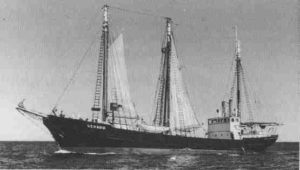- Author
- NHSA Webmaster
- Subjects
- RAN operations, WWII operations, History - WW2
- Tags
-
- RAN Ships
- None noted.
- Publication
- September 2010 edition of the Naval Historical Review (all rights reserved)
There are many tales to be told about Gerard’s two visits to New Guinea, but we’ll leave those to the reunion. However one incident that nearly brought the ship to its end should be recorded. On the night of 3/4 May 1944, Gerard landed right on the beach, literally, palm trees included. It was in ‘no man’s land’, about half way between Lae and Dreger Harbour. Fortunately, there were no troops from either side in the area. It was a navigational error and the Skipper lost his command as a result. In due course, he was succeeded by Lieutenant Lorraine.

Efforts in the morning to get off the beach failed, and around midday a US Army F-5 Craft was contacted by visual signal and asked to stand by. Further help came from an Australian LCM. The two ships teamed up with tow ropes to Gerard, and the stern wire anchor rope was laid out to sea. The three ships pulled at full strength and suddenly Gerard was afloat. Alas, in the course of pulling the anchor rope, 30 turns of anchor wire wrapped round the propeller. HMAS Goulburn, which had been directed to the scene, sent down divers and it was decided the only solution was for Goulburn to tow us to Dreger Harbour where the ship was soon repaired.
Gerard left Milne Bay on 1 November 1944 for Sydney to refit at Balmain, and after a good spell again headed north on 6 April 1945. Others will have to tell the story of the second voyage.
The war was over when Gerard left Port Moresby on 29 September 1945, only to be towed to Sydney, finally arriving home in Adelaide on 20 February, 1946.
Gerard paid off on 8 April 1946 and was returned to her owners. Her fine lines were restored. What a pity we didn’t see her in such splendour. Then it was back to peacetime trading which included wheat in Spencers Gulf, general cargo and timber between Adelaide, Burnie and Smithton. The old lady also operated the potato run between Sydney and Ulverstone for some time.
In 1962, she was sold to Julius Chan & Co. (Julius Chan became the Deputy Prime Minister of New Guinea), and was soon engaged in salvaging the cargo of the Shaw Savill Liner Runic, which was wrecked on Middleton Reef near Norfolk Island. She then left for New Guinea and traded with the New Britain Company to the Solomon Islands. The sixties and seventies passed and the old lady reached her sixtieth birthday in 1981, but later in that year, she sank peacefully in Open Bay, a harbour about 30 miles from Rabaul.
Despite what we thought of her at the time and the jibes we had to take from the ‘smarter’ ships of war, she outlived all of them. Our short period of but a few years was only a small part of Gerard’s life but probably her most unusual and exciting years. Similarly, our stay on board was but a short part of our lives, but an adventure we would not have missed for quids!
Author’s note: This story was made possible by the ex-crew members at the 1993 re-union.




